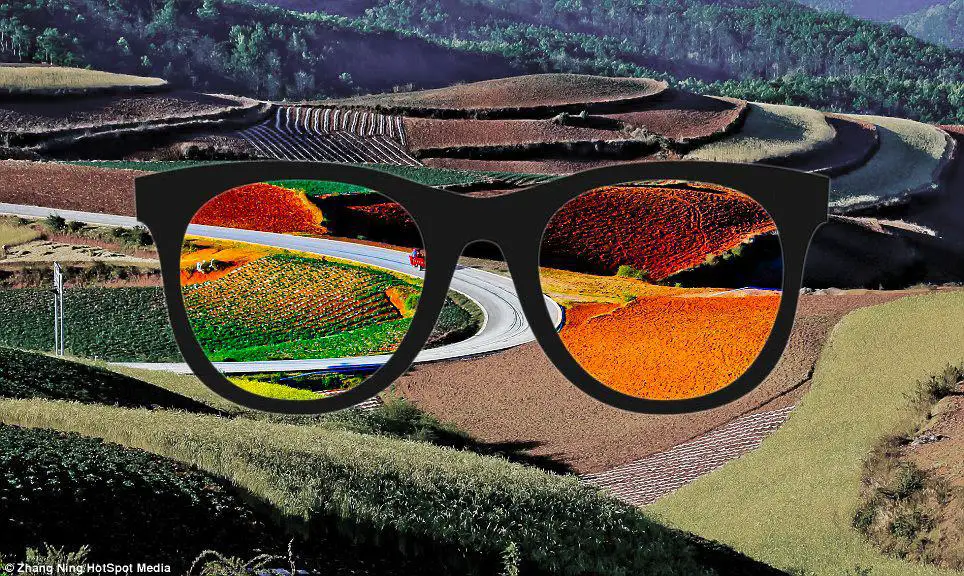There are a small number of specialized glasses that can help people with certain types of color blindness see colors more vibrantly. However, the technology is still in the early stages and has limitations. Glasses cannot give fully normal color vision to those with complete color blindness. But they may enhance color perception for those with more moderate forms of color vision deficiency. Let’s explore the current state of technology for color blindness glasses.
What causes color blindness?
Color blindness, also known as color vision deficiency, is a condition where a person has difficulty distinguishing between certain colors. It is usually caused by an abnormality in the development of certain cells in the retina that are sensitive to color.
There are different types of color blindness:
– Red-green color blindness is the most common. Red and green appear more similar.
– Blue-yellow color blindness is rarer. Blue and yellow are harder to tell apart.
– Complete color blindness is very rare. The world appears in shades of gray.
Color blindness is usually inherited genetically and much more common in men than women. About 1 in 12 men and 1 in 200 women have some type of color vision deficiency.
How do color blindness glasses work?
Specialized glasses for color blindness work by using optical filters to change the wavelengths of light entering the eye. This alters the way the eye perceives color.
Different filters target different types of color blindness:
– Red-green color blindness: A filter blocks overlapping wavelengths of light for red and green. This increases the separation between reds and greens.
– Blue-yellow color blindness: A filter blocks overlapping wavelengths of blue and yellow light. This makes blues and yellows more distinct.
– Complete color blindness: Filters may block certain wavelengths so some colors like reds appear darker. This can help distinguish them from lighter greens.
The filter lenses essentially fine-tune the colors entering the eye. This tweaks the color perception for those with color vision deficiencies.
What color blindness glasses are available?
Here are some of the color blindness glasses currently on the market:
| Brand | Features |
|---|---|
| EnChroma | Filters for red-green and blue-yellow color blindness |
| PixieVision | Filters for moderate red-green and blue-yellow color blindness |
| Iristech | Filters for mild red-green color blindness |
| X-Chrom | Filters targeted for sports and gaming |
The most well-known brand is EnChroma. They offer glasses with patented optical filters that target the common forms of red-green and blue-yellow color blindness. Other brands like PixieVision and Iristech offer similar filter technology at a lower price point.
Specialized gaming and sports glasses by X-Chrom also help with color distinction using optical filters. These are marketed towards activities where color perception affects performance.
How effective are they?
Studies testing color blindness glasses have had mixed results on their effectiveness. The level of improvement seems to depend on the individual and severity of their color vision deficiency.
In many cases, the glasses do appear to make colors seem slightly more vibrant and distinct. But the enhancement is often fairly modest. The glasses will not give those with complete color blindness full normal color vision. However, those with milder forms of color blindness may notice a difference in their ability to pick out or differentiate colors wearing the glasses.
More research is still needed, but initial studies suggest the glasses are most effective for:
– Red-green color blindness
– Milder forms of color deficiency
– Colors along the red-green color spectrum
For complete color blindness, the glasses unfortunately do not restore full color vision. But some report being able to distinguish a few colors while wearing them.
What are the drawbacks?
While color vision glasses can enhance color perception, there are some limitations to be aware of:
– Results vary greatly by individual. Some report significant improvements while others notice little difference.
– The glasses do not work equally well across all colors. They mainly enhance shades along the red-green spectrum.
– Effects seem temporary. Colors appear more vibrant when first putting the glasses on, but the enhancement reduces with prolonged wear.
– The glasses do not cure color blindness. They must be worn continually to provide an effect.
– The technology remains expensive. Costs range from $100 for mild color deficiency glasses up to $400-500 for brands like EnChroma.
– More research is still needed to back up effectiveness claims.
For these reasons, many eye doctors consider color blindness glasses a novelty rather than a medical treatment. The technology is improving but still has limitations compared to normal human color vision.
Will the technology advance?
As research progresses, color vision glasses are likely to improve:
– Filters can be better tuned to specific color vision deficiencies.
– Lens technology like photochromic could maintain enhancement effects longer.
– Costs should come down as technology develops further.
– Understanding of the neuroscience behind color perception could lead to new innovations.
However, fundamental limitations will remain. Glasses can only optimized the light entering the eye. They cannot correct full color processing in the brain that creates color blindness from birth. So enhancement of color perception will always be partial.
Conclusion
Specialized glasses using optical filters show promise in enhancing color perception for certain types of color blindness. But the results vary greatly for individuals and technology remains in early stages. While vision glasses cannot cure color blindness, they may provide modest improvements in color differentiation for some wearers. As research continues, the glasses are likely to incrementally improve and become more affordable and accessible. But full correction of color perception deficits will remain challenging. For those with color vision deficiency interested in trying color glasses, managing expectations and thoroughly testing effectiveness will be important.


